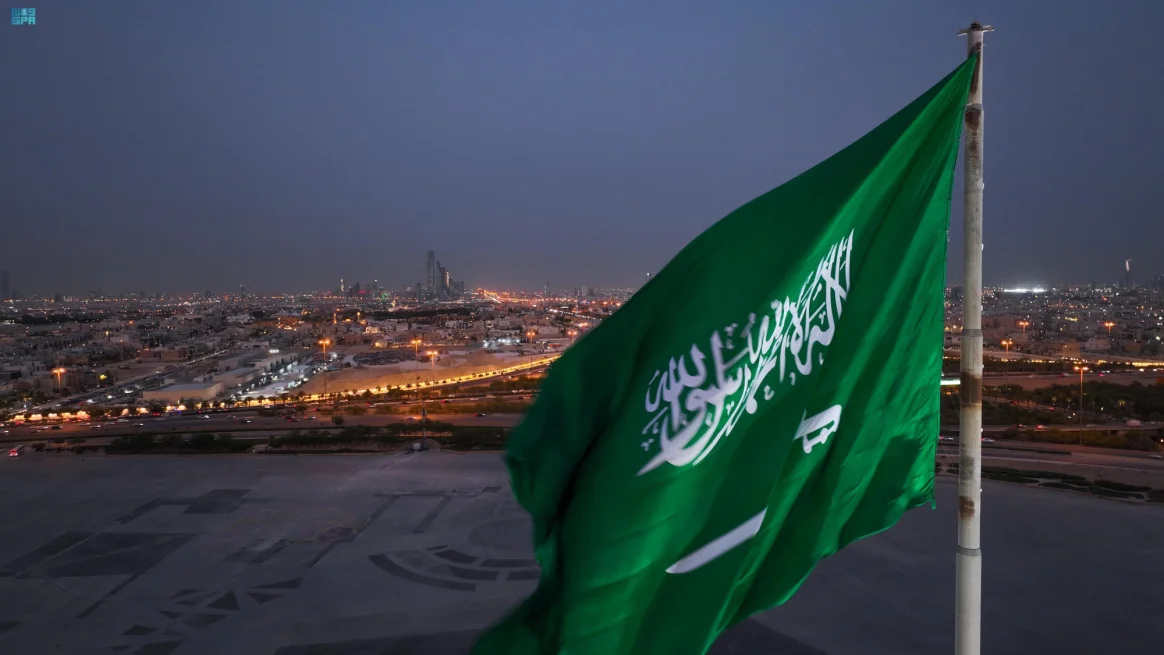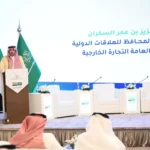The Kingdom’s flag flutters atop the “Diriyah Flagpole,” the tallest flagpole in the capital city of Riyadh, in a scene that reflects the depth of national belonging and the Kingdom’s pride in its rich history. Located in King Salman Square in historic Diriyah, one of the most prominent national landmarks that combines the glory of the past with aspirations for the future.
Transforming the “Diriyah Gate” into a global destination for culture, heritage, and tourism
The “Diriyah Flagpole” blends traditional Najdi architectural style with aesthetic dimensions, as its design reflects Saudi identity and serves as a striking visual landmark that reinforces Diriyah’s presence on the national tourism map. It highlights the city’s features and solidifies its historical and cultural symbols.
The flagpole is part of the “Diriyah Gate” project, which aims to transform the area into a global destination for culture, heritage, and tourism. It serves as a focal point in tourist tours that include the Turaif district, a UNESCO World Heritage Site, along with museums, traditional markets, and cultural centers, aligning with the goals of Saudi Vision 2030. This enhances Diriyah’s appeal as a comprehensive historical and tourist destination.
The square surrounding the “Diriyah Flagpole” hosts numerous national and community events, especially during official occasions such as National Day and Founding Day. It becomes a platform that expresses the unity between leadership and the people, instilling national values in Saudi society. Its exceptional height makes it visible from various parts of the city, reinforcing its presence in the urban landscape as a symbol of national unity.
The “Diriyah Flagpole” represents one aspect of investment in qualitative tourism in the Kingdom, offering an experience that combines cultural, historical, and entertainment dimensions. This reflects the successful integration of heritage and modernity, contributing to comprehensive tourism development goals. It strengthens the Kingdom’s position on the regional and international tourism map, establishing it as a global destination that attracts visitors with unique experiences.
With ongoing infrastructure development projects in Diriyah, the flagpole has become part of an integrated cultural scene that reflects the Kingdom’s rich history. It provides visitors with a holistic experience that blends heritage, identity, and modernity, fostering pride in the nation and connecting generations to their glorious history, in line with the Kingdom’s vision for a bright future under ambitious leadership.
Diriyah Flagpole
The **Diriyah Flagpole**, located in Diriyah, Saudi Arabia, is one of the tallest flagpoles in the world, standing at 171 meters (561 feet). Erected in 2021, it symbolizes Saudi heritage and national pride, situated near the historic At-Turaif district, a UNESCO World Heritage Site and the original home of the Saudi royal family. The flagpole flies the Saudi Arabian flag, representing the country’s deep-rooted history and modern ambitions.
King Salman Square
King Salman Square is a prominent public square located in Riyadh, Saudi Arabia, named in honor of King Salman bin Abdulaziz Al Saud. The square serves as a key cultural and social hub, often hosting national celebrations, events, and gatherings. Its design reflects modern Saudi architecture while symbolizing the country’s heritage and the leadership of King Salman.
Diriyah Gate
Diriyah Gate is a historic and cultural site in Saudi Arabia, located in the ancient city of Diriyah, the original home of the Saudi royal family and the first capital of the First Saudi State (1744–1818). Once a thriving political and religious center, it was designated a UNESCO World Heritage Site in 2010 for its well-preserved mud-brick architecture and significance in Arabian history. Today, it has been revitalized as a major tourism and heritage project, showcasing traditional Najdi culture, museums, and restored landmarks like the At-Turaif district.
Turaif district
The Turaif district, located in Riyadh, Saudi Arabia, is the historic heart of the city and the original home of the Al Saud royal family. Founded in the 15th century, it served as the first capital of the Saudi dynasty and features traditional Najdi architecture, including the iconic Salwa Palace. Today, it is a UNESCO World Heritage Site and part of the Diriyah development project, preserving its cultural and historical significance.
UNESCO World Heritage Site
A UNESCO World Heritage Site is a landmark or area recognized by the United Nations Educational, Scientific and Cultural Organization (UNESCO) for its outstanding cultural, historical, scientific, or natural significance. These sites, such as the Great Wall of China, the Pyramids of Egypt, or the Galápagos Islands, are protected to preserve their value for future generations. The World Heritage program began in 1972 and now includes over 1,000 sites worldwide, celebrating humanity’s shared heritage and natural wonders.
Saudi Vision 2030
“Saudi Vision 2030” is a strategic framework launched in 2016 by Crown Prince Mohammed bin Salman to reduce Saudi Arabia’s dependence on oil, diversify its economy, and develop public service sectors like health, education, and tourism. The plan includes ambitious projects like NEOM, a futuristic smart city, and aims to strengthen cultural and entertainment opportunities, such as opening the country to international tourists. Rooted in the Kingdom’s long-term goals, it seeks to transform Saudi society while preserving Islamic values and national heritage.
National Day
“National Day” typically refers to a country’s annual celebration of its independence, founding, or significant historical event. For example, China’s National Day on October 1 commemorates the founding of the People’s Republic of China in 1949, marked by festivities like parades and fireworks. Similarly, France’s Bastille Day (July 14) celebrates the 1789 French Revolution, reflecting national pride and unity. The specific history and traditions vary by country.
Founding Day
“Founding Day” is a national holiday in Saudi Arabia celebrated on February 22, commemorating the establishment of the First Saudi State in 1727 by Imam Muhammad bin Saud. The day honors the country’s historical roots, unity, and leadership under the Al Saud dynasty, culminating in the modern Kingdom of Saudi Arabia in 1932. Festivities include cultural events, fireworks, and displays of national pride.






